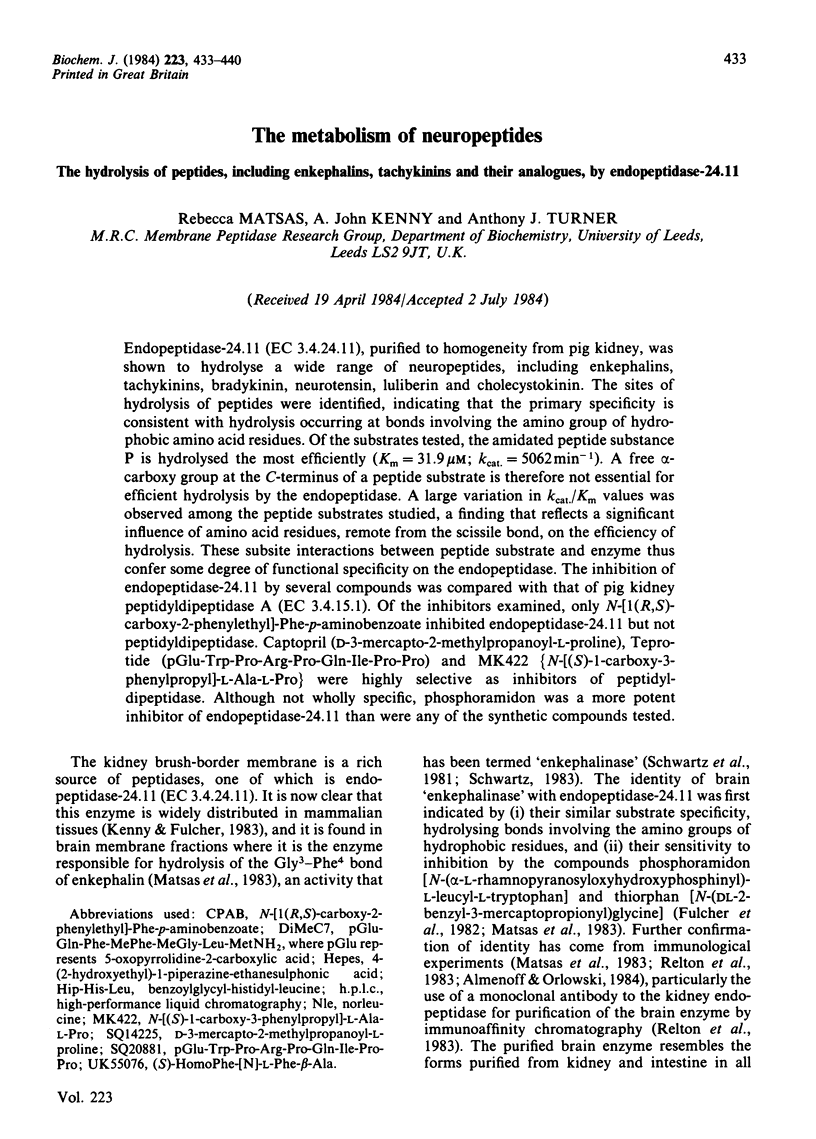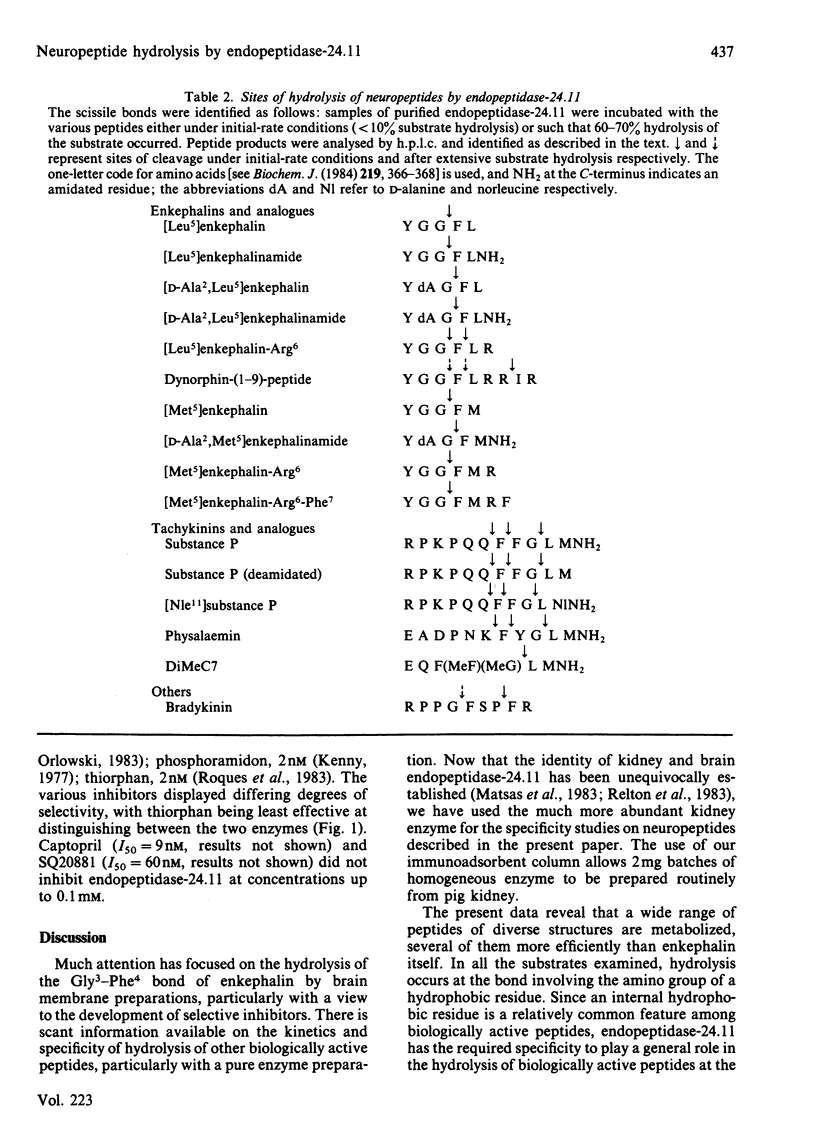Abstract
Endopeptidase-24.11 (EC 3.4.24.11), purified to homogeneity from pig kidney, was shown to hydrolyse a wide range of neuropeptides, including enkephalins, tachykinins, bradykinin, neurotensin, luliberin and cholecystokinin. The sites of hydrolysis of peptides were identified, indicating that the primary specificity is consistent with hydrolysis occurring at bonds involving the amino group of hydrophobic amino acid residues. Of the substrates tested, the amidated peptide substance P is hydrolysed the most efficiently (Km = 31.9 microM; kcat. = 5062 min-1). A free alpha-carboxy group at the C-terminus of a peptide substrate is therefore not essential for efficient hydrolysis by the endopeptidase. A large variation in kcat./Km values was observed among the peptide substrates studied, a finding that reflects a significant influence of amino acid residues, remote from the scissile bond, on the efficiency of hydrolysis. These subsite interactions between peptide substrate and enzyme thus confer some degree of functional specificity on the endopeptidase. The inhibition of endopeptidase-24.11 by several compounds was compared with that of pig kidney peptidyldipeptidase A (EC 3.4.15.1). Of the inhibitors examined, only N-[1(R,S)-carboxy-2-phenylethyl]-Phe-p-aminobenzoate inhibited endopeptidase-24.11 but not peptidyldipeptidase. Captopril (D-3-mercapto-2-methylpropanoyl-L-proline), Teprotide (pGlu-Trp-Pro-Arg-Pro-Gln-Ile-Pro-Pro) and MK422 [N-[(S)-1-carboxy-3-phenylpropyl]-L-Ala-L-Pro] were highly selective as inhibitors of peptidyldipeptidase. Although not wholly specific, phosphoramidon was a more potent inhibitor of endopeptidase-24.11 than were any of the synthetic compounds tested.
Full text
PDF







Selected References
These references are in PubMed. This may not be the complete list of references from this article.
- Algeri S., Altstein M., de Simone G. M., Guardabasso V. In vivo potentiation of [D-Ala2]Met-enkephalin amide central effects after administration of an enkephalinase inhibitor. Eur J Pharmacol. 1981 Sep 11;74(2-3):261–262. doi: 10.1016/0014-2999(81)90541-0. [DOI] [PubMed] [Google Scholar]
- Almenoff J., Orlowski M. Biochemical and immunological properties of a membrane-bound brain metalloendopeptidase: comparison with thermolysin-like kidney neutral metalloendopeptidase. J Neurochem. 1984 Jan;42(1):151–157. doi: 10.1111/j.1471-4159.1984.tb09711.x. [DOI] [PubMed] [Google Scholar]
- Almenoff J., Orlowski M. Membrane-bound kidney neutral metalloendopeptidase: interaction with synthetic substrates, natural peptides, and inhibitors. Biochemistry. 1983 Feb 1;22(3):590–599. doi: 10.1021/bi00272a011. [DOI] [PubMed] [Google Scholar]
- Benuck M., Marks N. Co-identity of brain angiotensin converting enzyme with a membrane bound dipeptidyl carboxypeptidase inactivating Met - enkephalin. Biochem Biophys Res Commun. 1979 May 14;88(1):215–221. doi: 10.1016/0006-291x(79)91718-2. [DOI] [PubMed] [Google Scholar]
- Chaillet P., Marçais-Collado H., Costentin J., Yi C. C., De La Baume S., Schwartz J. C. Inhibition of enkephalin metabolism by, and antinociceptive activity of, bestatin, an aminopeptidase inhibitor. Eur J Pharmacol. 1983 Jan 21;86(3-4):329–336. doi: 10.1016/0014-2999(83)90181-4. [DOI] [PubMed] [Google Scholar]
- Favila L., Howes E. L., Taylor W. A., Mitchison N. A. An adoptive cell transfer system for the evaluation of immunity to Herpes simplex virus in mice. Clin Exp Immunol. 1982 May;48(2):307–314. [PMC free article] [PubMed] [Google Scholar]
- Fournié-Zaluski M. C., Soroca-Lucas E., Waksman G., Llorens C., Schwartz J. C., Roques B. P. Differential recognition of "enkephalinase" and angiotensin-converting enzyme by new carboxyalkyl inhibitors. Life Sci. 1982 Dec 27;31(26):2947–2954. doi: 10.1016/0024-3205(82)90060-1. [DOI] [PubMed] [Google Scholar]
- Fulcher I. S., Kenny A. J. Proteins of the kidney microvillar membrane. The amphipathic forms of endopeptidase purified from pig kidneys. Biochem J. 1983 Jun 1;211(3):743–753. doi: 10.1042/bj2110743. [DOI] [PMC free article] [PubMed] [Google Scholar]
- Fulcher I. S., Matsas R., Turner A. J., Kenny A. J. Kidney neutral endopeptidase and the hydrolysis of enkephalin by synaptic membranes show similar sensitivity to inhibitors. Biochem J. 1982 May 1;203(2):519–522. doi: 10.1042/bj2030519. [DOI] [PMC free article] [PubMed] [Google Scholar]
- Gee N. S., Matsas R., Kenny A. J. A monoclonal antibody to kidney endopeptidase-24.11. Its application in immunoadsorbent purification of the enzyme and immunofluorescent microscopy of kidney and intestine. Biochem J. 1983 Aug 15;214(2):377–386. doi: 10.1042/bj2140377. [DOI] [PMC free article] [PubMed] [Google Scholar]
- Hudgin R. L., Charleson S. E., Zimmerman M., Mumford R., Wood P. L. Enkephalinase: selective peptide inhibitors. Life Sci. 1981 Dec 21;29(25):2593–2601. doi: 10.1016/0024-3205(81)90632-9. [DOI] [PubMed] [Google Scholar]
- Kenny A. J., Fulcher I. S. Microvillar endopeptidase, an enzyme with special topological features and a wide distribution. Ciba Found Symp. 1983;95:12–33. doi: 10.1002/9780470720769.ch3. [DOI] [PubMed] [Google Scholar]
- Kerr M. A., Kenny A. J. The purification and specificity of a neutral endopeptidase from rabbit kidney brush border. Biochem J. 1974 Mar;137(3):477–488. doi: 10.1042/bj1370477. [DOI] [PMC free article] [PubMed] [Google Scholar]
- Loh Y. P., Brownstein M. J., Gainer H. Proteolysis in neuropeptide processing and other neural functions. Annu Rev Neurosci. 1984;7:189–222. doi: 10.1146/annurev.ne.07.030184.001201. [DOI] [PubMed] [Google Scholar]
- Malfroy B., Schwartz J. C. Purification and substrate specificity of rat kidney "enkephalinase". Life Sci. 1982 Oct 18;31(16-17):1745–1748. doi: 10.1016/0024-3205(82)90200-4. [DOI] [PubMed] [Google Scholar]
- Malfroy B., Swerts J. P., Guyon A., Roques B. P., Schwartz J. C. High-affinity enkephalin-degrading peptidase in brain is increased after morphine. Nature. 1978 Nov 30;276(5687):523–526. doi: 10.1038/276523a0. [DOI] [PubMed] [Google Scholar]
- Matsas R., Fulcher I. S., Kenny A. J., Turner A. J. Substance P and [Leu]enkephalin are hydrolyzed by an enzyme in pig caudate synaptic membranes that is identical with the endopeptidase of kidney microvilli. Proc Natl Acad Sci U S A. 1983 May;80(10):3111–3115. doi: 10.1073/pnas.80.10.3111. [DOI] [PMC free article] [PubMed] [Google Scholar]
- Mumford R. A., Zimmerman M., ten Broeke J., Taub D., Joshua H., Rothrock J. W., Hirshfield J. M., Springer J. P., Patchett A. A. Inhibition of porcine kidney "enkephalinase" by substituted-N-carboxymethyl dipeptides. Biochem Biophys Res Commun. 1982 Dec 31;109(4):1303–1309. doi: 10.1016/0006-291x(82)91919-2. [DOI] [PubMed] [Google Scholar]
- Orlowski M., Wilk S. Purification and specificity of a membrane-bound metalloendopeptidase from bovine pituitaries. Biochemistry. 1981 Aug 18;20(17):4942–4950. doi: 10.1021/bi00520a021. [DOI] [PubMed] [Google Scholar]
- Patchett A. A., Harris E., Tristram E. W., Wyvratt M. J., Wu M. T., Taub D., Peterson E. R., Ikeler T. J., ten Broeke J., Payne L. G. A new class of angiotensin-converting enzyme inhibitors. Nature. 1980 Nov 20;288(5788):280–283. doi: 10.1038/288280a0. [DOI] [PubMed] [Google Scholar]
- Patey G., De La Baume S., Schwartz J. C., Gros C., Roques B., Fournie-Zaluski M. C., Soroca-Lucas E. Selective protection of methionine enkephalin released from brain slices by enkephalinase inhibition. Science. 1981 Jun 5;212(4499):1153–1155. doi: 10.1126/science.7015510. [DOI] [PubMed] [Google Scholar]
- Relton J. M., Gee N. S., Matsas R., Turner A. J., Kenny A. J. Purification of endopeptidase-24.11 ('enkephalinase') from pig brain by immunoadsorbent chromatography. Biochem J. 1983 Dec 1;215(3):519–523. doi: 10.1042/bj2150519. [DOI] [PMC free article] [PubMed] [Google Scholar]
- Roques B. P., Fournié-Zaluski M. C., Soroca E., Lecomte J. M., Malfroy B., Llorens C., Schwartz J. C. The enkephalinase inhibitor thiorphan shows antinociceptive activity in mice. Nature. 1980 Nov 20;288(5788):286–288. doi: 10.1038/288286a0. [DOI] [PubMed] [Google Scholar]
- Roques B. P., Lucas-Soroca E., Chaillet P., Costentin J., Fournié-Zaluski M. C. Complete differentiation between enkephalinase and angiotensin-converting enzyme inhibition by retro-thiorphan. Proc Natl Acad Sci U S A. 1983 Jun;80(11):3178–3182. doi: 10.1073/pnas.80.11.3178. [DOI] [PMC free article] [PubMed] [Google Scholar]
- Rush R. S., Hersh L. B. Multiple molecular forms of rat brain enkephalinase. Life Sci. 1982 Aug 2;31(5):445–451. doi: 10.1016/0024-3205(82)90329-0. [DOI] [PubMed] [Google Scholar]
- Sandberg B. E., Lee C. M., Hanley M. R., Iversen L. L. Synthesis and biological properties of enzyme-resistant analogues of substance P. Eur J Biochem. 1981 Feb;114(2):329–337. doi: 10.1111/j.1432-1033.1981.tb05152.x. [DOI] [PubMed] [Google Scholar]
- Schwartz J. C., Malfroy B., De La Baume S. Biological inactivation of enkephalins and the role of enkephalin-dipeptidyl-carboxypeptidase ("enkephalinase") as neuropeptidase. Life Sci. 1981 Oct 26;29(17):1715–1740. doi: 10.1016/0024-3205(81)90182-x. [DOI] [PubMed] [Google Scholar]


